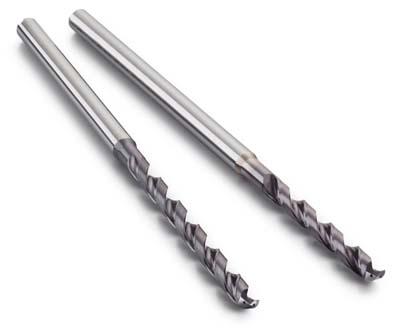
The new Sandvik Coromant solid carbide micro drills offer outstanding performance for holes from 0.073 inches to 0.116 inches in diameter. The CoroDrill 862 has a thin TiAlN coating that helps retain cutting edge geometry and provides a smooth surface for chip evacuation. This helps prolong tool life in workpiece materials that include steel, stainless steel, cast iron and aluminum.
The innovative post treatment on the CoroDrill 862, combined with specially designed point geometry, reduces the thrust forces and promotes fast and efficient chip removal. This is aided further by Advanced Chip Management (ACM) flute geometry, which helps evacuate the chips. This is vital in micro-drilling as even the smallest accumulation can lead to problems such as drill breakage, loss of precision, downtime and scrap.
The CoroDrill 862 also provides good hole entry and exit, and achievable hole tolerance of IT8-IT9. Internal coolant holes deliver coolant directly to the tip of the drill, even at deep drilling depths, to further assist precision and chip removal.
Available in drill lengths of 8-12 x D, the drills are only for use with HydroGrip high precision chucks from Sandvik Coromant.
Contact Details
Related Glossary Terms
- coolant
coolant
Fluid that reduces temperature buildup at the tool/workpiece interface during machining. Normally takes the form of a liquid such as soluble or chemical mixtures (semisynthetic, synthetic) but can be pressurized air or other gas. Because of water’s ability to absorb great quantities of heat, it is widely used as a coolant and vehicle for various cutting compounds, with the water-to-compound ratio varying with the machining task. See cutting fluid; semisynthetic cutting fluid; soluble-oil cutting fluid; synthetic cutting fluid.
- titanium aluminum nitride ( TiAlN)
titanium aluminum nitride ( TiAlN)
Often used as a tool coating. AlTiN indicates the aluminum content is greater than the titanium. See coated tools.
- tolerance
tolerance
Minimum and maximum amount a workpiece dimension is allowed to vary from a set standard and still be acceptable.

